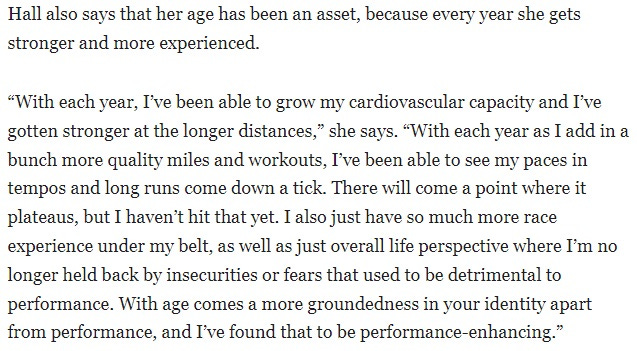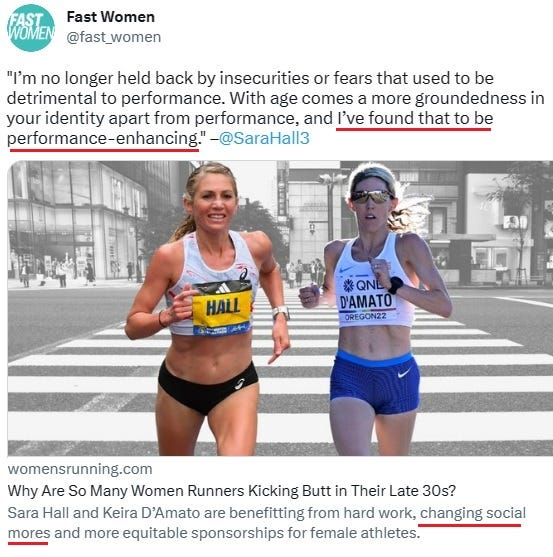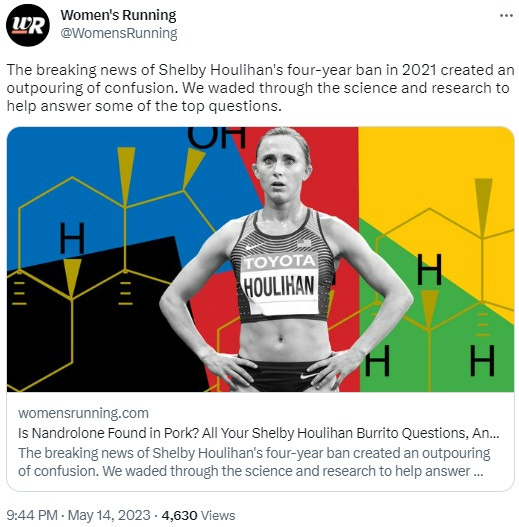Women's Running continues to push the "novelty" of over-35 superstars while offering all but the likeliest explanation
Producers of dubious content could at least learn some real history while generating it
In the summer of 1997, American middle-distance runner Ruth Wysocki ran times of 2:03.95 for 800 meters and 4:08.69 for 1,500 meters. Wysocki, who competed in the 1984 Olympic Games in her home state of California in both the 800 meters and the 1,500 meters, was 40 years old. Wysocki still holds the American masters’ outdoor records in both events.
Also at those 1984 Olympic Games was Great Britain’s Priscilla Welch, who finished sixth in the marathon in 2:28:54. Despite the heat of the day, the time was a personal best for Welch, a former smoker who had only been running for about four years. At the 1987 London Marathon, Welch, at the age of 42, lowered her best time to 2:26:51.
At the 2000 Olympics in Sydney, Merlene Ottey of Jamaica, who already held seven Olympic medals (none of them gold) when she landed in Australia, finished fourth in the 100-meter dash in a time of 11.19. Ottey had turned 40 earlier that year. In addition to winning a silver medal in Sydney, Ottey was awarded the 2000 bronze medal for the 100 meters in 2009 when winner Marion Jones of the United States was stripped of her medals from the Games for doping. The funny thing about that is that Ottey had tested positive for steroids in 1999, a finding the Jamaica Amateur Athletic Association ignored, then bullied her way into a spot in the open 100 meters in Sydney despite finishing fourth at Jamaica’s Olympic Trials.
In February 2003, another native Californian, Regina Jacobs, age 39, ripped through seven and a half laps at the Reggie Lewis Track Athletic Center at the adidas Boston Indoor Games in 3:59.98, setting an indoor world record for 1,500 meters. Jacobs, known for her various championship-level battles with American 1,500-meter star and future entrepreneur Suzy Favor Hamilton, was a three-time Olympian and retired as the holder of twenty-five individual U.S. titles. The reason she retired was being flagged for doping a few months after that excellent sub-four 1,500 meters undercover.
In April of 2004 in St. Louis, South African-born American Colleen De Reuck won the U.S Olympic Marathon Team Trials in 2:28:25. Ten days later she celebrated her 40th birthday. Constantina Diță of Romania won the 2008 Olympic Marathon at the age of 38. In 2016, 41-year-old Jennifer Rhines, a 2008 5,000-meter Olympian, ran 15:45 for 5,000 meters in Palo Alto, California to set an American masters record. Rhines also ran road times of 15:51 for 5K, 32:33 for 10K, and 1:12:35 for the half marathon past the age of forty.
In 2017, Shalane Flanagan crafted perhaps the most memorable non-Olympic road race ever by an American when she upset Mary Keitany to win the New York City Marathon, breaking the Kenyan mother-of-two’s three-year NYCM winning streak. Flanagan was 36, the same age Keitany was when she reclaimed the title the next year in Central Park in a time of 2:22:48.
Two things should be clear: It’s long been common for women well past the age of 35 to excel in long-distance running, and it’s a good idea to as suspicious of standout performances by pre- and proto-geezers as everyone is of crazy-fast marks by any athlete.
The objective mundanity of fast runners who are in or beyond their latter thirties didn’t stop Women’s Running from publishing an article in February 2022 titled “Age is Just a Number: Why Elite Women Over 35 are Crushing It.” Focusing on marathon specialists Sara Vaughn, Sara Hall, and Keira D’Amato, the writer, Ali Nolan, interviewed someone she described as an expert on aging in athletes as well as “the differences between male and female runners,” the latter despite the denial of such differences in other Women’s Running stories and in other publications the Outside, Inc. domain. This expert’s conclusion was that “social factors” were primarily responsible for women like D’Amato and Hall getting faster and faster as they approach or even pass the age of forty. The piece doesn’t mention doping or PEDs at all.
Apparently, this article didn’t go far enough in “answering” the question of why runners can make gains at improbable ages, and certainly didn’t hammer away at bizarre and inane hypotheses. On Monday, Women’s Running revisited the topic with a piece titled “Why Are So Many Women Runners Kicking Butt in Their Late 30s?”
Hall, D’Amato, and Vaughn are again the stars of Claire Trageser’s story. And although Nolan’s fifteen-month-old story has “The Pattern is Not New” as one of its subheads, Trageser chose to refer to the success of these three crones as “a revolution.” She also refers to Hall as a mother, which is true, but she doesn’t note that Hall has never given birth.
An excerpt:
Previously, the expectation was that athletes of all kinds, especially runners, peak in their late 20s after college. But scientists, coaches and runners themselves are questioning that assumption for women. Because of the biology of hormones, new research is suggesting that women peak later, in their 30s. But until now, the sport hadn’t given them the chance to demonstrate that. Especially not women who’d had babies.
“The biology of hormones” covers a great deal of territory. But that throwaway phrase isn’t in the same class of hilarity as Hall’s own words:
“There will come a point where it plateaus” suggests that Hall—who turned 40 two days before last month’s Boston Marathon and sleeps next to someone capable of adding muscle mass so rapidly that his own slumbering body makes noises like slowly expanding Styrofoam—thinks she may become faster still. And why shouldn’t she? The rules of the sport are obviously being applied differently to, say, Australian-born Irishwomen than they are to Kenyan athletes.
Alison Wade of Fast Women can be counted on to supply tweets that indicate that she’s either as oblivious about PED use as everyone else, willfully or otherwise, or as wise as the most jaded doper but only willing to communicate this in code.
Also, on Sunday, Women’s Running chose to re-amplify one of its own nearly two-year-old stories about Shelby Houlihan admitting five months into a four-year ban from the sport that she was, in fact, in the sports pokey and hadn’t been injured all spring.
On the surface, this is a strange move. The excuses offered on Houlihan’s behalf looked bad enough in real time, but they look even more ridiculous now, with folks like Ross Tucker having explored the since-released granular findings of the court that upheld Houlihan’s suspension. I suppose that almost everyone who thought Houlihan was innocent then was destined to believe this in perpetuity, because to anyone with experience in the sport and a partially functioning brain, Houlihan was as dirty as the day is long even before she was officially flagged and sanctioned.
However, the surface is misleading. Keep in mind that almost all of your favorite running “journalists” and publications of 2023, not to mention The New York Times, are beneficiaries of some Nike founder Phil Knight’s estimated $54 billion fortune.
Magic Boost is to running what the Bill and Melinda Gates Foundation are to public health: An influence-peddling and message-directing operation framed as a means of popularizing the sport. It’s a way to keep people like Lindsay Crouse or Chris Chavez, who are plenty inept and unethical on their own, from ever again participating in any public shamings of Nike athletes who test positive for banned substances, get arrested, or otherwise show their asses. It’s a way to keep running great again, especially when the ages of the four most prominent running pundits at any time don’t even sum to Knight’s age, and none of them care to learn anything about the sport’s history.





